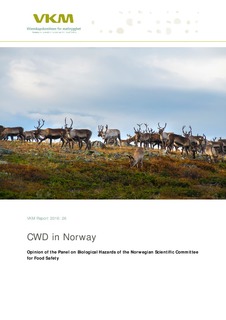| dc.description.abstract | The Norwegian Food Safety Authority (NFSA) and Norwegian Environmental Authority (NEA) asked the Norwegian Scientific Committee for Food Safety (Vitenskapskomiteen for mattrygghet, VKM) for an opinion on factors associated with the introduction of Chronic Wasting Disease (CWD) to Norway. VKM appointed a working group consisting of two members of the Panel on Biological Hazards, one member of Panel on Animal Health and Welfare, and two external experts to prepare the answer to the questions. The Panel on Biological Hazards has reviewed and revised the draft prepared by the working group and approved the opinion. CWD was diagnosed in March 2016 in a wild reindeer (Rangifer tarandus) from the Nordfjella mountain area in Norway and in May and June in two mooses (Alces alces) in Selbu in South Trøndelag County, approximately 300 km north from the first case. There is currently no information to determine the origin(s) of CWD agents in Norway. However, the sporadic or genetic (somatic mutation) occurrence of prion disease in cervids cannot be excluded, nor can introduction from North America or other countries. Furthermore, there is no evidence that it has not been circulating at low levels in the Norwegian cervid populations for years, but has not previously been identified. In this scientific opinion, information on prion diseases in general, and CWD in particular, is presented in the light of experiences with this disease in North America. Prions are among the most resilient pathogens known and dissemination of prions into ecosystems is likely to result in long-term problems. Prions bind strongly to soil and remain infectious. In CWD, prions are present in most peripheral organs and also shed into the environment via saliva, faeces, and urine, as well as with the placenta. CWD transmits easily among cervids, either through direct contact, or indirectly via the environment. Migration of animals is relevant for the spread between areas. Strain diversification might occur in CWD and may influence transmission properties of the agents. Clinical signs of CWD are non-specific and do not alone enable confirmation of the diagnosis. Analysis of tissue from the brainstem at the level of the obex by approved methods is necessary for diagnosis of CWD. Prion infectivity is assessed by bioassays, often involving transgenic mice. In vitro conversion assays, like protein misfolding cyclic amplification (PMCA), provide sensitive quantification of converting activity, which is a good approximation of infectivity. Genetic variation (polymorphisms) in the gene that encodes PrP (PRNP) can modulate sensitivity towards CWD. The level of such genetic variation in Norwegian wild and semi- domesticated cervids is currently unknown. Cattle and sheep are at very low risk of developing CWD and it is highly unlikely that prion diseases in sheep or cattle are the origin of CWD. VKM Report 2016: 26 6 Although transmission of CWD to humans has never been known to occur, and animals other than cervids have not been found to be infected, indicating a species barrier, this possibility cannot be excluded. Thus, measures for reduction of human exposure are recommended. Taking into account uncertainties regarding the plasticity of the CWD agents and the lack of transmission data from the Norwegian isolates, this scientific opinion considers the zoonotic risk of CWD to be very low. | |
